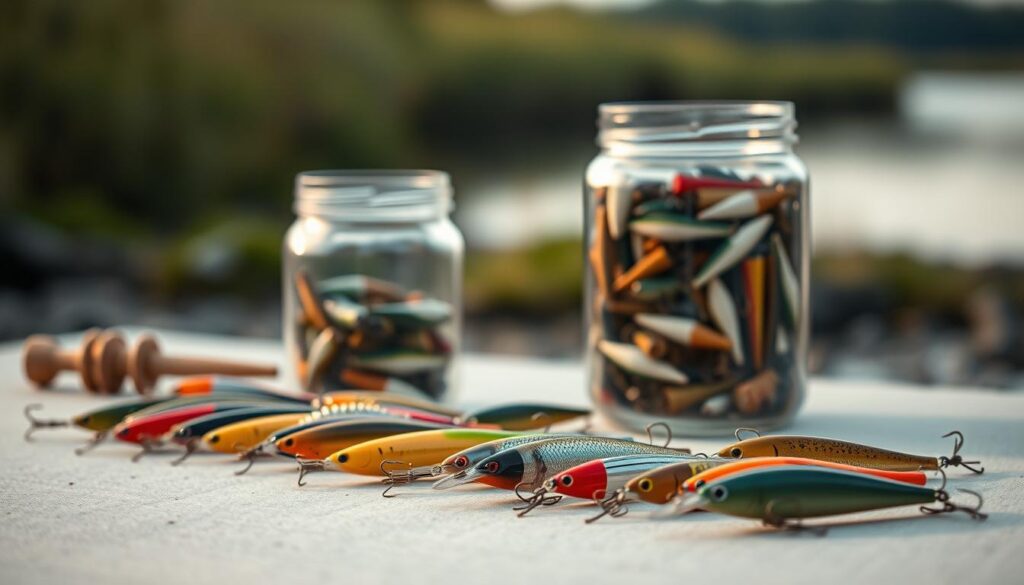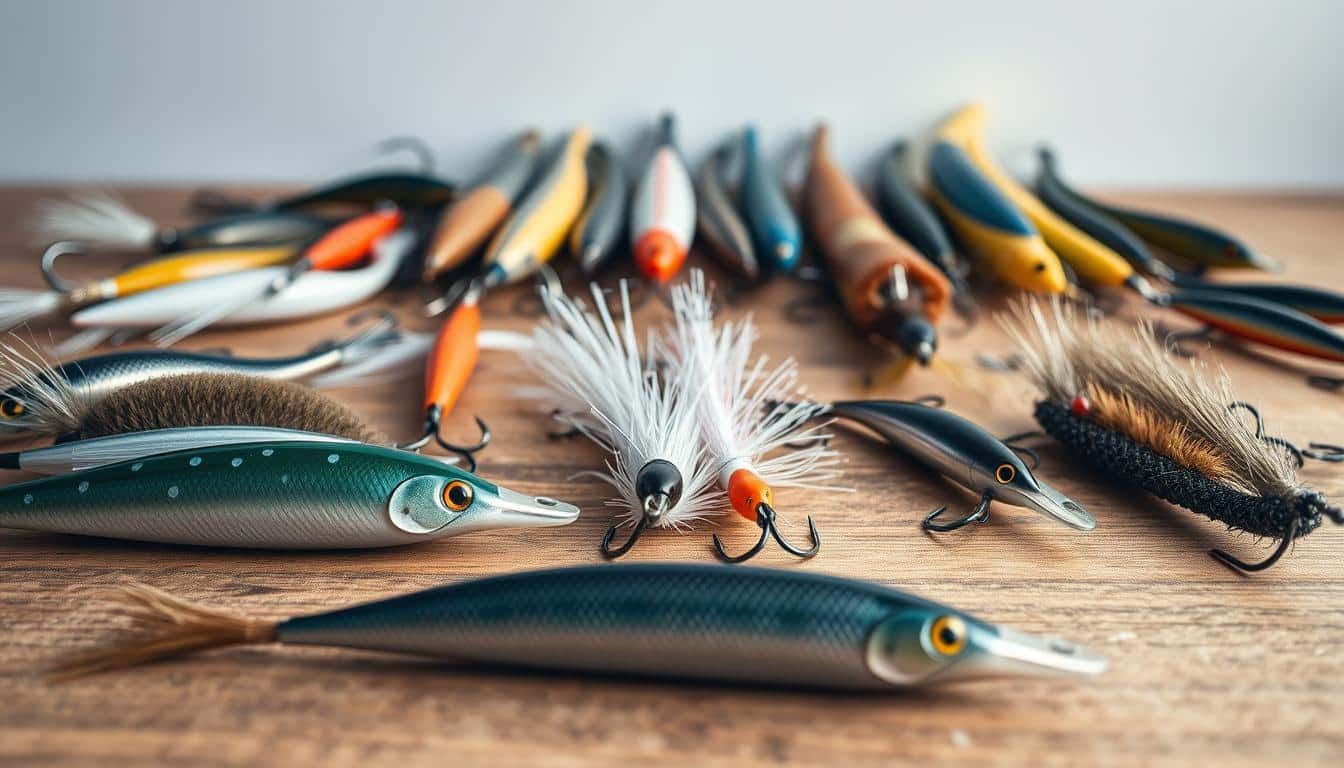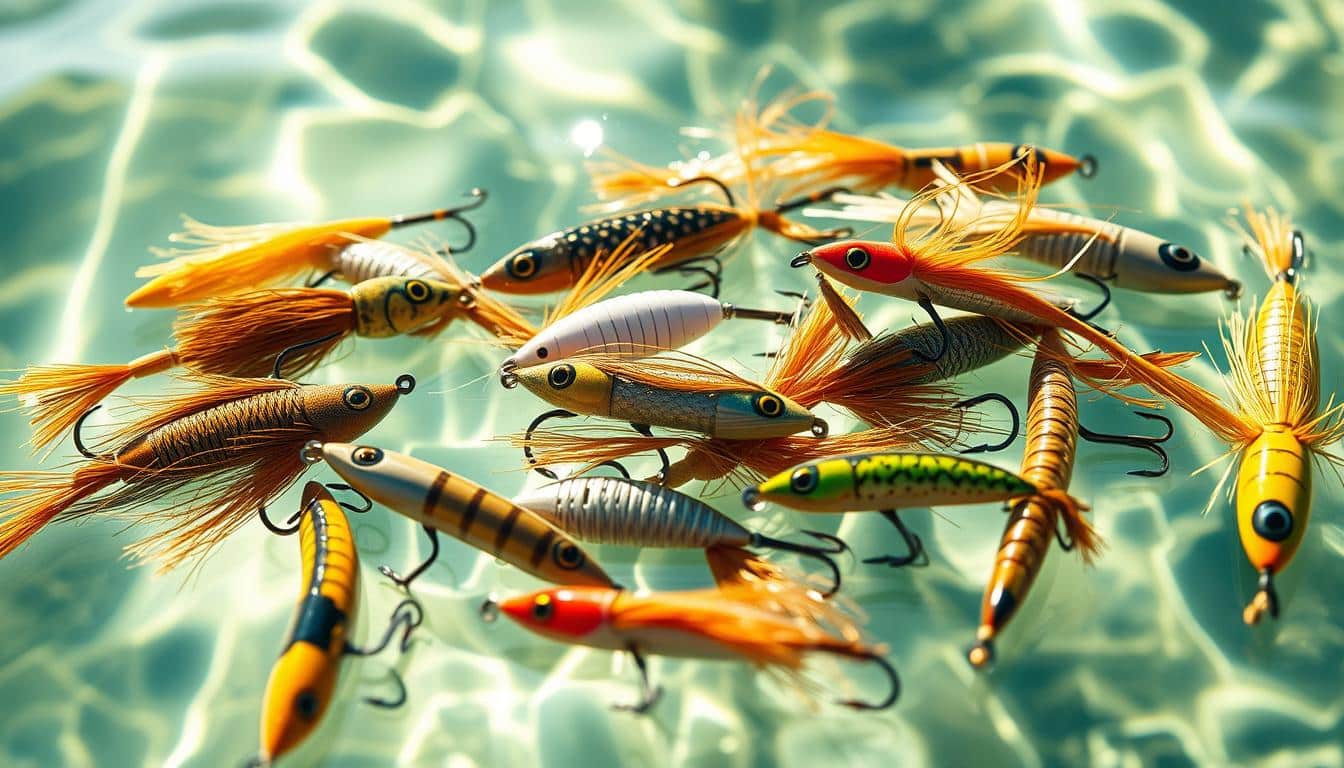Anglers across the U.S. have a big choice. They can keep using soft plastics or switch to lures that help the environment. Every year, 14 million U.S. anglers choose gear. This choice impacts fish, birds, and where they live. So, understanding biodegradable and plastic-free lures is key.
This piece digs into Biodegradable vs Plastic-Free Fishing Lures. You’ll learn what these terms mean and about materials used, like gelatin. We’ll also explain what “plastic-free” really means. Plus, you’ll find out why choosing sustainable gear is good for the planet.
We provide tips on how well these lures work, buying advice, and how to take care of them. Companies like Eco-Logical Lures are making products with glycerin, gelatin, and fish oil. These aim to be as effective as traditional lures but better for the environment. This article helps you pick gear that’s good for your catch and the planet.
What are biodegradable and plastic-free fishing lures?
Anglers seeking eco-friendly gear have two main choices. Biodegradable fishing lures decompose naturally with eco-friendly ingredients. Plastic-free lures skip synthetic materials, offering a real step toward zero plastic use.
Definitions and core differences
Biodegradable lures are made to be broken down by nature. They’re crafted to last in use but not in the environment. Plastic-free options don’t use common hazardous materials, focusing on a cleaner formula.
Common materials used in biodegradable lures (gelatin, glycerin, plant-based polymers)
- Gelatin fishing lures blend gelatin, glycerin, and salt for a more eco-friendly option. They lure fish effectively but don’t last as long in nature.
- Glycerin lures mix glycerin with natural polymers for flexibility and biodegradability.
- Plant-based polymers provide a durable, less harmful alternative for those looking to reduce environmental impact.
What “plastic-free” means in lure manufacturing (zero plastisol, no phthalates)
Plastic-free means absolutely no plastisol or harmful synthetics. Such lures avoid harmful phthalates to protect the environment better. Products claiming “100% biodegradable” and “plastic free” should clearly show their ingredients.
Brands like Eco-Logical Lures reveal their formulas and tests. This transparency helps anglers choose between longevity and ecological impact. Whether it’s gelatin or glycerin, this insight supports informed decisions towards sustainability.
History and landscape of fishing lures in the United States
The evolution of fishing lures in the U.S. shows how materials, angler habits, and environmental concerns have changed. Wooden and metal lures were replaced by soft-plastic ones in the 1900s. This change paved the way for today’s fishing gear market and discussions on sustainability.
Soft-plastic lures became popular for their realistic shapes and easy color changes. They were made from materials like PVC to look and smell like real prey. This innovation made them a favorite among bass anglers and in competitions.
The rise of soft plastics transformed both retail and manufacturing. Brands like Zoom Bait Company and Berkley made these lures widely available. Their large-scale production made the lures inexpensive and found everywhere from lakes to seas.
About 14 million anglers in the U.S. contribute to the amount of gear used. Even losing a few lures makes a big pollution problem. This has sparked talks about pollution and the need for better ways to dispose of gear.
Fishers are now more aware of plastic pollution and its dangers. There are campaigns that aim to educate about using gear wisely. Efforts like Pledge to Pitch It ask anglers to reduce loss and use biodegradable lures.
Smaller companies are now creating sustainable lures to meet demand. These U.S. brands often use natural ingredients and produce locally. They stand out by being open about what’s in their lures and offering handmade products.
- Traditional advantages: lifelike action, long shelf life, color variety that fueled soft plastic lures popularity.
- Environmental pressure: increased reporting on plastic pollution has driven consumer interest in alternatives tied to the history of fishing lures US.
- Market response: eco-friendly fishing brands and small producers offer new materials and local manufacturing aimed at reducing lost-tackle impacts.
The industry now looks to balance fishing performance with environmental care. Anglers, shops, and manufacturers weigh options as they adjust to new values and angler participation in the U.S.
Environmental impacts of traditional plastic lures
Traditional soft plastic lures come from materials like PVC. They harm freshwater and coastal environments. These lost or thrown away lures don’t go away easily. They stay on shorelines and bottoms of lakes for years, showing how hard they are to get rid of. This makes cleaning up tough and harms the places where fish live.
Plastic lure pollution is seen in soft bait chunks and bits in the dirt underwater. These pieces slowly break apart but never fully go away. As time passes, they turn into tiny bits that are tough to clean up.
Wildlife gets hurt by these forgotten lures. Fish and birds often eat these lures, thinking they are food. This can block their stomachs, make them eat less, and even cause death if the plastic gets stuck in their bodies.
There’s also the danger of chemicals from these plastics. Soft plastics have harmful substances like phthalates that can spread into water and living things. Even the warnings on these products show they’re bad for fish and people who fish.
As plastics break down, they turn into microplastics. These tiny plastics get into rivers and lakes and harm the food chain. Tiny water creatures eat them, then fish eat those creatures. This can lead to bigger animals and even humans eating contaminated food.
- Persistent debris alters habitat structure and burial of sediments.
- Ingestion of lures by wildlife can lead to secondary harm when predators eat affected prey.
- Microplastics in freshwater remain suspended or settle, making monitoring and removal difficult.
Fishers and those who look after our waters must consider these effects when choosing fishing gear. To fight plastic pollution from lures, it starts with knowing their dangers. Knowing how they last long, harm animals, and contribute to the issue of microplastics and polluted water food chains is key.
Advantages of biodegradable fishing lures
Biodegradable fishing lures help anglers lower their impact on nature without losing out on quality. They use materials like gelatin, glycerin, and plant ingredients. These contents break down much faster than traditional PVC lures. This decrease in breakdown time lessens pollution and keeps the lure working well in water.
Faster breakdown times compared with conventional plastics
Biodegradable lures can break down in a few months to years, which varies with water temperature and bacteria activity. Old-style soft plastics can stick around for a very long time. The quicker breakdown time greatly benefits those fishing in rivers, lakes, and seas who often lose their gear.
Reduced microplastic generation and lower chemical leaching
Biodegradable lures are made to totally decompose, not just crumble into small pieces. This limits microplastics in our water. They’re made from natural materials and skip harmful chemicals found in regular plastics. This reduces the risk of poisoning our water.
Potential benefits for catch-and-release practices (nutritional, non-toxic formulas)
Some biodegradable lures are enhanced with fish oil or nutrients. This means if a fish swallows a piece and is released, it’s less likely to be harmed. These lures support catch-and-release by making recovery easier for the fish. They’re also made without harmful chemicals, offering a safer option for fishing that’s good for the environment.
- Balance is key: manufacturers test durability to ensure lures stay on the hook while in use.
- Reduced microplastics and non-toxic lures support healthier aquatic habitats.
- Catch-and-release friendly lures offer a more ethical choice for sport anglers.
Advantages of plastic-free fishing lures
Using plastic-free fishing lures means less reliance on synthetic materials. Fishers use lures that don’t have plastisol or other common additives. This leads to fewer chemicals leaking into waterways and less toxic residue on your hands and gear.
Below are key health and environmental advantages:
- No phthalates lure benefits: By eliminating phthalates like diisononyl phthalate, we reduce exposure to potential carcinogens for frequent lure users.
- There’s less pollution in water habitats from lost or thrown away lures, which means cleaner shorelines and sediments over time.
- With fewer microplastics breaking down, there’s a lower risk of dangerous particles being ingested by fish, birds, and other wildlife.
No synthetic polymers or phthalates — health and environmental advantages
Plastic-free lures use natural or food-safe materials instead of chemical resins. This switch means fewer lasting pollutants and toxins in our waters.
Scent and taste strategies (fish oil infusion) to improve strike rates
Lure makers add scent to make them more appealing. Lures with fish oil smell real and taste convincing to cautious fish. This can turn a near miss into a catch.
But fish oil does more than attract. If a fish bites a lure, food-grade oils can provide a bit of nutrition. This might help the fish recover in catch-and-release fishing.
Handmade and local production benefits (quality control, reduced carbon footprint)
Small businesses in the U.S. often make lures by hand and check each one. This means better quality checks for biodegradable lures than big company products. Each lure is carefully inspected for reliable action and scent.
Producing lures locally and in small batches reduces travel for the product and helps local economies. This usually results in less pollution for each lure made, although the overall environmental impact depends on the company and how much they make.
- Making smaller amounts allows for quick changes based on environmental tests and feedback.
- When makers and fishers talk directly, it’s easier to know about the lure’s materials and how it’s made.
Performance comparison: do eco lures catch fish as well as traditional lures?
Anglers find that eco-friendly lures work just as well as the usual soft plastics. Tests from makers and independent studies show eco lures can move like real fish if made right. Catch rates for fish like bass, trout, and redfish are good, based on real-life tests.

- Companies like Eco-Logical Lures did over 150 tests to perfect their lures’ movement and toughness.
- Fishers note that biodegradable lures hook fish almost as well as standard baits in short tests.
- Reports say plant-based lures, especially when scented, work well even in water where fish are wary.
How material choices affect action, durability, and scent release
- Using glycerin and gelatin in lures makes them move naturally and smell strong, though they may be softer than usual plastics.
- The right mix in the recipe can make a lure’s movement realistic and help it hold onto the hook.
- Lures can wear out faster if they spend too much time in water or under the sun.
Tactics for using biodegradable or plastic-free lures effectively
- Rigging: Use setups that avoid weeds and choose jig heads like those for soft plastics, but be gentle to not tear the bait.
- Storage: Keep eco lures cool and away from the sun to keep their shape and last longer.
- Presentation: Choose lures that match the fish and water you’re targeting. Scented lures can be more effective in clear, busy waters.
- Replacement: Change lures that wear out to avoid fish swallowing them and to keep catching fish.
Switching to biodegradable lures mostly requires small changes, not a complete shift in how you fish. Handle them a bit differently, know they won’t last forever, but feel good about less harm to the environment. And you’ll still catch plenty of fish.
How to choose between biodegradable and plastic-free lures
Start by thinking about what’s important to you. Consider the lure’s impact on the environment, its lifespan, your budget, and the fish you’re after. Some anglers pick biodegradable or plastic-free lures to lessen environmental harm. Others might need gear that lasts longer for intense fishing.
How long a lure lasts should match how you use it. Biodegradable lures might break down quicker than plastic ones, but not always at the same rate. Plastic-free choices may avoid harmful chemicals and keep their scent longer, which helps in tricky waters. Consider how often you lose lures to weigh the cost of eco-friendly ones.
Be thorough when reading lure labels. Look for ingredients like glycerin, gelatin, or plant-based stuff. Phrases like “zero plastisol,” “no diisononyl phthalate,” or “100% biodegradable” should be checked. Trust brands more if they share test results, how fast their lures break down, or how they make them.
- Look for clear info from brands and any tests by others.
- Go for exact ingredient lists over vague eco-friendly claims.
- If details are missing on the label, ask the seller or the maker before buying eco-friendly lures.
Try out brands known for biodegradable lures and those made by smaller companies before changing all your tackle. Eco-Logical Lures, for example, openly shares what goes into their lures and how they’re made. Many anglers like this direct, local approach. Shops that focus on specialty tackle and care about conservation are good places to find such options.
- Begin with a few types to see how they perform in your waters.
- See how they stack up to your usual PVC baits across a few fishing trips.
- If those eco-friendly options work for you, then look into different types suited for various fish.
When buying eco-friendly lures, choose sellers that back up their claims and have clear policies on returns or testing. Small producers, online shops, and specialty stores usually offer more honesty than big chains. Trying a few out first can save money and help find the right mix of cost, durability, and environmental friendliness.
Practical care, disposal, and best practices for anglers
Good care makes eco lures last longer and keeps our waters clean. Follow easy steps to reduce tackle loss. Handle broken gear the right way. Small actions by individual anglers matter a lot when everyone does it together.

Proper disposal and minimizing lost tackle
Always check your knots and gear before casting to avoid losing lures. Choose the right swivels and hooks for the fish you’re after. This helps stop gear from getting stuck.
If you can’t get a lure back, cut the line near the water. Let local cleanup groups know about these spots.
When lures can’t be used anymore, get rid of them as the maker says. Join efforts like Pledge to Pitch It. They help anglers throw away damaged lures and gear at boat ramps and shores the right way.
Storage, longevity, and handling tips
Keep biodegradable and plastic-free lures cool and out of the sun. Store different lures separately to stop them from reacting or melting together.
After using lures in saltwater, wash and dry them well. Rotate your lures to use them evenly and check them for damage. Throw away lures that can’t be composted to protect animals.
Community actions: cleanups, education, and supporting sustainable gear manufacturers
Help out at local cleanups to get rid of lost fishing gear. Take part in events that teach people how to dispose of gear properly. These are hosted by groups that care about nature.
- Encourage shops to stock biodegradable lures and to label eco-friendly options clearly.
- Buy from brands like Eco-Logical Lures that are open about what’s in their products.
- Support local cleanups and join Pledge to Pitch It for a positive impact on fishing.
Conclusion
This conclusion highlights the choices and chances for anglers who want to fish with care. Biodegradable lures, often made from gelatin or plant stuff, and plastic-free ones, made from things like glycerin or fish oil, are better for the planet. They break down easier, create fewer tiny plastic pieces, and leak fewer chemicals than the usual soft plastics like PVC. And, thanks to new designs, these eco-friendly options work just as well for catching fish.
When choosing, think about what matters more to you: how long the lure lasts, how much it costs, and the fish you’re after, or its environmental footprint. Look for labels that say things like “no PVC” or “made with gelatin/glycerin,” and try different ones in your local fishing spots. Keeping lures well and throwing them away properly helps them last longer and keeps the water clean. Also, supporting companies that make gear with the planet in mind makes a big difference.
In the U.S. alone, there are about 14 million anglers. If each person makes small changes, like using biodegradable or plastic-free lures and handling them carefully, it can hugely reduce the plastic pollution in our waters and its harm to wildlife. This summary suggests easy steps: check what the lures are made of, test out a few, and choose brands that care about making products safe for the environment.
FAQ
What is the difference between biodegradable and plastic-free fishing lures?
What materials are commonly used in biodegradable lures?
What does “plastic-free” mean on a lure label?
How did soft-plastic lures become so common in the U.S.?
How big is the U.S. fishing market and why does lure choice matter?
Are there U.S. makers producing eco-conscious lures?
How long do traditional plastic lures last in the environment?
What harm do lost plastic lures cause wildlife?
Do conventional lures contribute to microplastic problems?
How quickly do biodegradable lures break down compared with PVC lures?
Will biodegradable or plastic-free lures leach harmful chemicals?
Do eco lures perform as well as traditional soft plastics?
How do material choices affect a lure’s action, durability, and scent?
How should I rig and present biodegradable or plastic-free lures?
How do I decide between biodegradable and plastic-free options?
What should I look for on labels to verify claims?
Where can I buy biodegradable or plastic-free lures?
How should I dispose of eco lures when they’re worn out?
What storage and handling tips extend the life of eco lures?
How can anglers reduce lost tackle and help clean up waterways?
Are there catch-and-release benefits to fish-oil–infused eco lures?
Are eco lures more expensive than traditional soft plastics?
Can switching to biodegradable or plastic-free lures really reduce plastic pollution?
Content created with the help of Artificial Intelligence.



